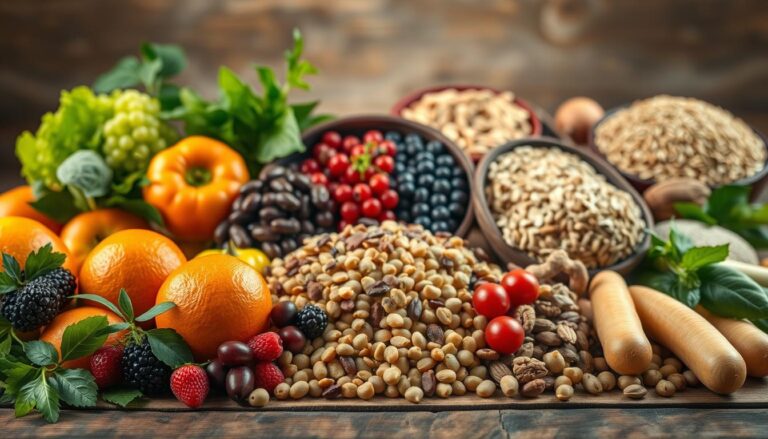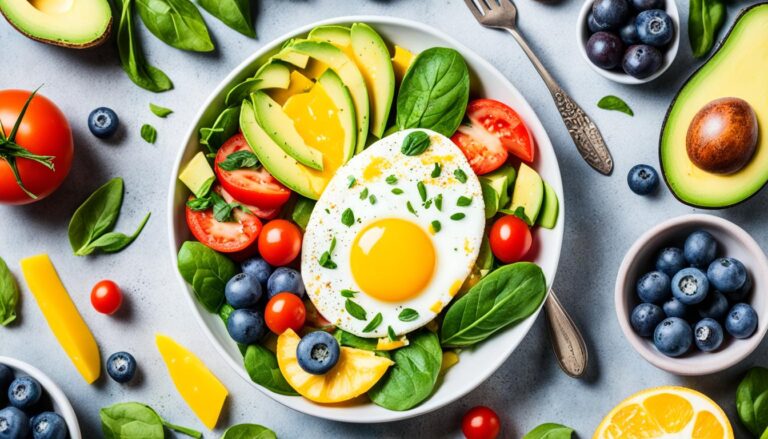Why do so many diets fail despite good intentions? Studies reveal that 93% of people regain lost weight within five years, often due to unsustainable methods. Lasting weight loss isn’t about extreme restrictions—it’s about science-backed habits that fit real life.
The CDC recommends gradual progress—1-2 pounds per week—for lasting results. Instead of chasing fads, focus on proven strategies like calorie awareness, intermittent fasting, and consistent movement. Partnering with trusted resources like Wellos by RVO Health ensures evidence-based guidance.
This guide explores 15 actionable methods, from optimizing metabolism to prioritizing nutrient-dense foods. Each tip is rooted in peer-reviewed research, offering a realistic path to health without deprivation.
Key Takeaways
- Most diets fail long-term; sustainable changes yield lasting results.
- Science supports gradual weight loss of 1-2 pounds weekly.
- Tracking calories and intermittent fasting are effective tools.
- Behavioral shifts matter more than short-term restrictions.
- Trusted platforms like Wellos provide medically reviewed strategies.
1. Understanding Weight Loss: Science vs. Fads
Flashy diet trends often overshadow scientifically proven weight management strategies. While quick fixes dominate headlines, research reveals that 80% of commercial diets fail long-term due to unsustainable restrictions. Lasting success requires understanding how the body truly responds to nutrition and exercise.
Why Fad Diets Fail
Popular myths—like juice cleanses “detoxing” the body—lack NIH-backed evidence. Extreme calorie slashing reduces basal metabolic rate (BMR) by 23%, triggering rebound weight gain. Consider these realities:
- Detox teas: No peer-reviewed studies support fat-loss claims.
- Ketosis hype: While burning fat, long-term keto diets may reduce muscle mass (Mayo Clinic).
- Metabolic adaptation: The body conserves energy when deprived, slowing progress.
“Rapid weight loss often sacrifices muscle, weakening metabolism over time.”
The Role of Metabolism
After age 30, metabolism declines 3–8% per decade, making calorie management harder. However, protein’s thermic effect (TEF) boosts energy expenditure by 15–30%, aiding sustainable weight loss. Key strategies:
- Prioritize lean protein to preserve muscle and elevate BMR.
- Strength training counters age-related metabolic slowdown.
- Small, frequent meals may stabilize blood sugar better than fasting for some.
Science-backed adjustments—not rigid diets—create lasting change.
2. Track Your Calories and Activity
Data-driven approaches outperform guesswork in sustainable weight management. Research shows MyFitnessPal users lose three times more weight than non-trackers, proving awareness fuels progress.
Benefits of Food Journals and Apps
Logging meals highlights hidden calorie sources, like sugary drinks or oversized portions. Apps like LoseIt! and Cronometer offer nutrient breakdowns, but accuracy varies:
- LoseIt!: User-friendly with barcode scanning; ideal for beginners.
- Cronometer: Lab-tested data for micronutrients; preferred by nutritionists.
A JAMA study found consistent tracking reduces BMI by 2.5 points within six months. Real-time feedback helps adjust habits before small gains become setbacks.
How Pedometers and Fitness Trackers Help
Non-exercise activity thermogenesis (NEAT)—like fidgeting or pacing—burns 350 kcal/day. Devices quantify movement using MET values:
- Walking (3.5 METs) burns fewer calories than cycling (7 METs).
- 10,000 steps/day torches 400–500 kcal, aiding 1-pound weekly loss.
“Smartwatches overestimate calorie burn by 27%. Pair trackers with food logs for balanced data.”
Combine tools for a holistic view. Sync apps with wearables to align intake with output.
3. Practice Mindful Eating
Eating with awareness transforms how the body processes food. Studies show mindful eaters consume 300 fewer calories daily by recognizing satiety cues. This approach contrasts with distracted habits, like 73% of Americans eating while watching TV—a practice linked to 28% larger portions.
Techniques to Slow Down
Hunger signals take 15–20 minutes to reach the brain. The 20-minute rule encourages pausing between bites to prevent overeating. Clinical studies demonstrate the “raisin meditation” technique:
- Observe texture, aroma, and taste before chewing.
- Chew slowly, noting flavor changes.
- Swallow only when fully broken down.
Avoiding Distractions During Meals
Dopamine spikes from screens override fullness cues. Harvard research confirms TV diners eat 14% more than those seated at tables. Compare outcomes:
| Distracted Eating | Mindful Eating |
|---|---|
| 28% larger portions | Accurate portion control |
| Delayed satiety signals | Faster recognition of fullness |
| Higher calorie intake | 300 kcal/day reduction |
“Stopping at 80% fullness (Hara Hachi Bu) extends lifespan and maintains healthy weight.”
4. Prioritize Protein in Your Diet
Among macronutrients, protein stands out for its dual impact on satiety and body composition. Research confirms high-protein breakfasts reduce daily calorie intake by 400 calories, while whey protein boosts appetite-suppressing GLP-1 hormones by 38%.
Protein’s Hunger-Regulating Effects
The amino acid leverage hypothesis explains how protein signals fullness. Compared to carbs or fats, protein triggers greater release of satiety hormones like peptide YY. Consider these sources:
- Greek yogurt (21g protein) vs. eggs (6g)
- Chicken breast (31g per 3oz) vs. lentils (9g per ½ cup)
Animal proteins score higher on the Digestible Indispensable Amino Acid Score (DIAAS) scale. However, plant-based combinations like quinoa with beans can achieve similar benefits.
Power-Packed Breakfast Options
Starting the day with 30g+ protein stabilizes blood sugar and reduces cravings. Try these science-backed meals:
- Turkey omelet with spinach (34g)
- Cottage cheese bowl with almonds (32g)
- Protein smoothie with Greek yogurt (30g)
“Exceeding 2.2g protein per kg body weight daily may strain kidney function in susceptible individuals.”
Balance is key—most adults thrive on 0.8-1.2g per pound of lean mass. Pair protein with fiber for optimal digestion and sustained energy.
5. Cut Back on Added Sugars and Refined Carbs
Hidden sugars lurk in everyday foods, sabotaging weight management efforts. The average American consumes 17 teaspoons of added sugar daily—triple the American Heart Association’s recommendation. This excess contributes to metabolic disorders and visceral fat accumulation.
The Link Between Sugar and Obesity
Refined carbohydrates increase visceral fat by 11% in just three months, according to metabolic studies. Processed sugars create advanced glycation end-products (AGEs) that accelerate cellular aging and insulin resistance.
Common culprits contain shocking amounts:
- BBQ sauce: 11g per tablespoon
- Flavored yogurt: 19g per cup
- Granola bars: 12g per serving
“High-glycemic foods spike blood sugar faster than table sugar, increasing diabetes risk.”
Healthy Swaps for Processed Foods
Choosing low-glycemic alternatives helps maintain stable energy levels. Compare these options:
| High-Glycemic | Low-Glycemic Alternative |
|---|---|
| White rice (73 GI) | Quinoa (53 GI) |
| Potato chips | Kale chips |
| Pasta | Zucchini noodles |
The NIDDK recommends limiting added sugars to 150g weekly for metabolic health. Try these whole-food substitutions:
- Cauliflower rice instead of white rice
- Nut butter instead of sugary spreads
- Fresh fruit instead of candy
- Sparkling water with citrus instead of soda
Gradual reductions allow taste buds to adapt while supporting sustainable weight management. Small changes yield significant long-term benefits for both body composition and overall health.
6. Increase Your Fiber Intake
Fiber plays a crucial role in digestive health and weight management, yet most overlook its benefits. Studies show soluble fiber reduces calorie absorption by 7%, while 95% of Americans fail to meet the 25g daily target. This nutrient slows digestion, stabilizes blood sugar, and feeds beneficial gut bacteria.

Fiber-Rich Foods to Include
Not all fibers function identically. Psyllium husk forms gel-like substances that trap fats, while beta-glucan in oats lowers cholesterol. Top sources include:
- Chia seeds: 10g per ounce
- Lentils: 15g per cooked cup
- Raspberries: 8g per cup
- Almonds: 3.5g per ounce
How Fiber Supports Gut Health
When gut bacteria ferment fiber, they produce short-chain fatty acids (SCFAs) like butyrate. This compound enhances fat oxidation and reduces inflammation. A BMJ study found 8g daily fiber decreases obesity risk by 23%.
“SCFAs signal the brain to reduce appetite while improving insulin sensitivity.”
Increase intake gradually to avoid bloating. Add 5g weekly until reaching 25-30g daily. Pair with adequate water to prevent constipation.
7. Harness the Power of Intermittent Fasting
Strategic meal timing has emerged as a powerful tool for sustainable weight control. Unlike traditional diets, intermittent fasting focuses on when to eat rather than what to eat. Research shows this approach reduces calorie intake by 300 kcal/day without conscious restriction.
Popular Protocols Compared
The 16/8 method—fasting for 16 hours daily—proves most sustainable for beginners. Alternate-day fasting (ADF) shows stronger metabolic benefits, improving insulin sensitivity by 18% in eight weeks. Consider these approaches:
- Warrior Diet: 20-hour fast with one large meal at night
- Eat-Stop-Eat: 24-hour fasts twice weekly
- 5:2 Diet: Normal eating five days, 500-600 calories two days
A New England Journal of Medicine study found intermittent fasting outperforms daily calorie restriction for fat loss. Participants maintained 4% more muscle mass while shedding visceral fat.
Safe Fasting Practices
Hydration and electrolyte balance prevent common side effects like headaches. These aids support longer fasts:
- Pink Himalayan salt for sodium
- Magnesium glycinate supplements
- Herbal teas (ginger, peppermint)
“Autophagy peaks at 48 hours, clearing damaged cells and boosting metabolic efficiency.”
Those with hypoglycemia or diabetes should consult doctors before fasting. Start with 12-hour overnight fasts, gradually increasing duration. Listen to your body’s hunger signals to avoid over-restriction.
8. Stay Hydrated to Curb Cravings
The body’s water balance directly influences hunger signals and calorie processing efficiency. Research reveals that drinking 17 oz of water boosts metabolism by 30% for one hour, creating a passive calorie-burning effect. Proper hydration also prevents mistaking thirst for hunger—a confusion that leads to 37% of unnecessary snacking.
The Science Behind Water and Metabolism
University of Utah research shows just 1% dehydration slows metabolic rate by 2%. Water facilitates lipolysis, the process of breaking down fat for energy. Key findings:
- Cold water may increase calorie burn slightly as the body works to warm it
- Timing matters—drinking before meals reduces calorie intake by 13%
- Electrolyte balance prevents hyponatremia (limit to 1L/hour during exercise)
Smart Beverage Swaps
Replacing one soda daily with water saves 50,000 calories yearly. Diet sodas present a paradox—while calorie-free, artificial sweeteners may spike insulin by 20%, potentially increasing cravings.
| High-Calorie Drink | Hydrating Alternative |
|---|---|
| Sweetened iced tea (180 kcal) | Herbal iced tea (0 kcal) |
| Frappuccino (420 kcal) | Cold brew with cinnamon (15 kcal) |
“Infused waters with cucumber or berries satisfy taste receptors without added sugar.”
Hydration apps like WaterMinder use personalized reminders, while Hydro Coach calculates needs based on activity. Aim for half your body weight in ounces daily, adjusting for sweat loss.
9. Optimize Your Gut Health
Emerging research reveals gut bacteria influence weight management more than previously understood. A Cell Host & Microbe study found microbial diversity predicts 7% greater weight loss success, while fermented foods like kimchi reduce waist circumference by 1.5 inches in 12 weeks. This gut-body connection operates through multiple pathways affecting metabolism and appetite regulation.

Probiotic and Prebiotic Powerhouses
Not all beneficial bacteria function identically. Lactobacillus gasseri specifically targets abdominal fat, while Bifidobacterium lactis improves insulin sensitivity. Synbiotic combinations—pairing probiotics with their preferred prebiotic fibers—create optimal conditions for microbial growth.
Top synbiotic foods include:
- Sauerkraut (unpasteurized): Provides live cultures with cabbage fiber
- Kefir: Contains 30+ strains plus milk oligosaccharides
- Jerusalem artichokes: Inulin fiber feeds bifidobacteria
- Tempeh: Fermented soy offers complete protein with prebiotics
“Fecal microbiota transplants from lean donors improved insulin sensitivity by 58% in obese recipients within six weeks.”
The Gut-Brain Metabolic Axis
The vagus nerve acts as a direct communication channel between gut microbes and the brain’s hunger centers. When certain bacteria break down fiber, they produce short-chain fatty acids that signal satiety. Disruptions in this system correlate with obesity and metabolic disorders.
Key considerations for dietary adjustments:
- Gradually increase fiber to avoid bloating (add 5g weekly)
- Rotate fermented foods for diverse strains
- Limit artificial sweeteners that alter microbial balance
Note: Excessive probiotic supplementation carries risk of small intestinal bacterial overgrowth (SIBO). Those with digestive issues should consult a gastroenterologist before making significant changes to gut health protocols.
10. Prioritize Quality Sleep
Chronic sleep deprivation alters hormone production, increasing obesity risk by 55% for those averaging under five hours nightly. The CDC links poor rest to elevated ghrelin (hunger hormone) and reduced leptin (satiety signals), creating metabolic imbalance. Unlike diet adjustments, sleep optimization requires behavioral changes with measurable metabolic payoffs.
The Orexin System and Carb Cravings
Insomnia overstimulates orexin neurons, triggering 45% stronger cravings for refined carbs according to Stanford sleep studies. This survival mechanism evolved to provide quick energy during prolonged wakefulness. Key findings:
- Each hour of lost sleep increases next-day calorie intake by 150-200 kcal
- Sleep extension to 7.5 hours reduces intake by 270 kcal/day
- Deep sleep stages regulate insulin sensitivity
Tracking Sleep Quality Effectively
Consumer devices vary in clinical accuracy. Comparative data from Johns Hopkins:
| Oura Ring | Fitbit Sense |
|---|---|
| 98% accuracy detecting sleep stages | 91% stage detection |
| Measures body temperature trends | Includes SpO2 monitoring |
“Sleeping 3.5 hours nightly for four days induces insulin resistance equivalent to six months on a high-fat diet.”
Circadian Fasting Protocol
Ceasing food intake 3 hours before bedtime aligns with natural melatonin release. This practice:
- Reduces nighttime acid reflux by 40%
- Enhances growth hormone production during sleep
- Prevents glucose metabolism disruption
Magnesium-Rich Sleep Support
This mineral regulates GABA receptors for relaxation. Top dietary sources per 100g:
- Pumpkin seeds: 262mg
- Spinach: 157mg
- Dark chocolate (85%): 146mg
The Military Sleep Technique
Developed for combat readiness, this method induces sleep in 2 minutes:
- Relax facial muscles completely
- Drop shoulders and exhale deeply
- Visualize a static scene for 10 seconds
Navy SEALs report 96% success rates after six weeks of practice. Pair with blackout curtains and 65°F room temperature for optimal results.
11. Manage Stress to Avoid Emotional Eating
Chronic stress silently undermines weight management efforts through hormonal disruptions. Research confirms elevated cortisol increases abdominal fat by 17% while triggering cravings for high-calorie foods. Addressing psychological factors proves essential for sustainable results.
Effective Stress-Reduction Methods
An ACE study found yoga reduces cortisol 26% more than walking. Meditation shows similar benefits—eight weeks of practice decreases emotional eating by 40%. Consider these evidence-based approaches:
- HRV biofeedback: Apollo Neuro measures real-time stress responses, while Muse provides neurofeedback during meditation
- Progressive muscle relaxation: Systematically tense/release muscle groups for full-body calm
- Breathwork: 4-7-8 breathing (inhale 4 sec, hold 7, exhale 8) activates parasympathetic response
Understanding Cortisol’s Impact
The hypothalamic-pituitary-adrenal (HPA) axis governs stress responses. Chronic activation leads to:
| Short-Term Effects | Long-Term Risks |
|---|---|
| Increased appetite | Insulin resistance |
| Fat storage preference | Muscle breakdown |
“Nightshift workers with disrupted cortisol rhythms gain 5+ pounds yearly despite similar calorie intake.”
Adaptogens for Stress Support
These plant compounds help the body adapt to stressors without suppressing normal function. Clinical evidence supports:
- Ashwagandha: Reduces perceived stress by 44% in controlled trials
- Rhodiola rosea: Improves fatigue resistance during prolonged stress
- Holy basil: Modulates cortisol production pathways
Note: Adrenal fatigue lacks diagnostic criteria, but HPA axis dysfunction is medically recognized. Those experiencing prolonged stress should consult healthcare providers for personalized evaluation.
12. Incorporate Regular Cardio Exercise
Cardiovascular activity reshapes metabolism beyond calorie burn. Research confirms HIIT torches 28% more fat than steady-state workouts, while 150 weekly minutes reduce visceral fat by 7%. Strategic movement patterns optimize results without excessive time investment.

Optimizing Fat-Burning Zones
Intensity dictates how the body fuels workouts. Compare three approaches:
- LISS (50-60% max heart rate): Burns fat directly but fewer total calories
- MISS (70-80%): Balances fat/carb use for endurance athletes
- HIIT (90%+): Creates afterburn effect (EPOC) up to 48 hours
A Journal of Sports Science study found alternating intensities yields better long-term results than sticking to one zone. Two weekly HIIT sessions plus three moderate sessions proves ideal.
Sustainable Routine Building
Consistency matters more than perfection. These home options require zero equipment:
- Jump rope intervals: 30 sec on/30 sec off
- Stair climbing: 10 flights daily burns 100 kcal
- Dance workouts: Zumba burns 400 kcal/hour
“NEAT activities like pacing burn 350+ kcal daily—equivalent to a 3-mile walk.”
Habit stacking pairs cardio with enjoyable tasks. Try audiobooks during treadmill sessions or work calls while walking. Marathoners often regain weight due to compensatory overeating—track intake to avoid this trap.
For accurate activity tracking, use NEAT calculators adjusting for:
- Occupation (desk jobs vs. manual labor)
- Commute methods
- Leisure activity levels
13. Add Strength Training to Preserve Muscle
Resistance training transforms body composition beyond calorie burning. While many focus solely on cardio for weight management, lifting weights provides unique metabolic advantages. Each pound of muscle burns 6 kcal daily—triple the energy of fat tissue—making it a powerful ally for sustained results.
Why Muscle Mass Matters
The mTOR pathway activates muscle protein synthesis during resistance exercise. This biological process helps counteract the 80% muscle loss typically seen during calorie restriction. Key mechanisms include:
- Increased growth hormone production
- Improved insulin sensitivity
- Enhanced post-exercise calorie burn (EPOC)
“Full-body strength workouts twice weekly preserve lean mass better than daily cardio alone.”
Beginner-Friendly Resistance Exercises
Equipment choice impacts effectiveness and safety. Compare options:
| Free Weights | Machines | Resistance Bands |
|---|---|---|
| Activates stabilizers | Fixed movement paths | Portable & affordable |
| Higher injury risk | Beginner-friendly | Variable resistance |
Effective compound movements engage multiple muscle groups:
- Deadlifts (hamstrings, glutes, back)
- Push-ups (chest, triceps, core)
- Squats (quads, glutes, calves)
Allow 48 hours recovery between sessions for muscle repair. Overtraining elevates cortisol, potentially hindering progress. Start with 2 sets of 8-12 reps per exercise, gradually increasing intensity.
14. Choose Whole, Single-Ingredient Foods
Modern grocery aisles overflow with packaged convenience, yet research links these options to metabolic disruption. Ultra-processed foods drive 500 extra calories daily compared to whole-food meals, per NIH studies. The NOVA classification system categorizes foods by processing level—with Group 1 being unprocessed and Group 4 containing industrial formulations.
The Problem with Processed Foods
Industrial processing strips fiber and nutrients while adding stabilizers and sweeteners. A Cell Metabolism study found whole foods increase diet-induced thermogenesis by 50% versus processed equivalents. Key concerns include:
- Emulsifiers disrupting gut microbiota balance
- High-fructose corn syrup overwhelming liver metabolism
- Artificial flavors overriding natural satiety signals
“Group 4 NOVA foods comprise 58% of average American calories, correlating with obesity trends.”
Nutrient-Dense Meal Ideas
Stocking a clean pantry simplifies healthy eating. These 20 staples form versatile meal foundations:
| Proteins | Complex Carbs | Healthy Fats |
|---|---|---|
| Wild-caught salmon | Quinoa | Avocados |
| Organic chicken | Sweet potatoes | Extra virgin olive oil |
The Environmental Working Group’s Dirty Dozen identifies produce with highest pesticide residues. Always opt for organic versions of:
- Strawberries and spinach
- Kale and nectarines
- Apples and grapes
Meal services like Sun Basket emphasize organic ingredients, while HelloFresh offers budget-friendly recipes. Balance is crucial—orthorexia risks emerge when diet rules become obsessive. A sustainable way forward combines whole-food focus with occasional flexibility for lasting health.
15. Set Realistic Goals and Celebrate Progress
The scale tells only part of the story—lasting transformation requires celebrating small wins. Research shows those focusing on non-scale victories maintain 63% better adherence to healthy habits. This approach aligns with set point theory, where the body resists rapid changes to preserve homeostasis.

The Science Behind Gradual Progress
Losing 1-2 pounds weekly yields 5x higher success rates than rapid drops. The hypothalamus interprets drastic calorie cuts as threats, triggering metabolic slowdown. Maintenance phases every 6-8 weeks allow hormonal rebalancing.
SMART goals create achievable frameworks:
- Specific: “Walk 30 minutes daily” vs. “Exercise more”
- Measurable: Track waist circumference weekly
- Actionable: Meal prep Sundays for weekday success
“Maintainers spend 60% less time obsessing over numbers, focusing instead on energy levels and clothing fit.”
Rewarding Milestones Without Food
Dopamine reinforcement strengthens new neural pathways. Consider these 50 evidence-backed rewards:
| Physical | Experiential | Social |
|---|---|---|
| Massage therapy | New hiking trail | Group fitness class |
| Foam roller | Cooking workshop | Charity 5K entry |
Cognitive distortions often derail progress. Common patterns include:
- All-or-nothing thinking after one indulgence
- Overgeneralizing plateaus as failures
- Discounting non-scale victories
For long term success, view maintenance as an active phase. Those maintaining 10% loss for six months triple their odds of keeping it off permanently. The journey isn’t linear—each small win builds lasting changes.
Conclusion: Building Sustainable Habits for Lifelong Health
Sustainable weight loss relies on consistent habits, not temporary fixes. Eighty percent of successful maintainers track intake, proving awareness remains crucial beyond initial progress.
Lifestyle changes outperform short-term diet approaches 94% of time. Focus on four pillars: balanced nutrition, regular movement, quality sleep, and stress management.
Twelve-month maintenance requires periodic adjustments. Reassess calorie needs every three months as metabolism adapts. Celebrate non-scale victories like improved energy and stamina.
Avoid all-or-nothing thinking—occasional indulgences won’t derail long term success. Platforms like Wellos offer ongoing support through maintenance phases.
The CDC confirms losing just 5-10% of body weight cuts diabetes risk by 58%. Small, steady steps create lasting health transformations.





